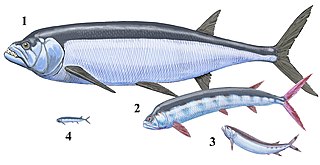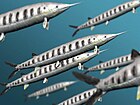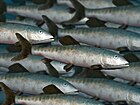
The Cretaceous is a geological period that lasted from about 145 to 66 million years ago (Mya). It is the third and final period of the Mesozoic Era, as well as the longest. At around 79 million years, it is the longest geological period of the entire Phanerozoic. The name is derived from the Latin creta, "chalk", which is abundant in the latter half of the period. It is usually abbreviated K, for its German translation Kreide.

Enchodus is an extinct genus of aulopiform ray-finned fish related to lancetfish and lizardfish. Species of Enchodus flourished during the Late Cretaceous, and survived the Cretaceous–Paleogene extinction event, persisting into the late Eocene.

Xiphactinus, colloquially referred to as the X-fish, is an extinct genus of large predatory marine bony fish that lived during the late Albian to the late Maastrichtian. The genus grew up to 5–6 metres (16–20 ft) in length, and superficially resembled a gargantuan, fanged tarpon.

Ichthyodectiformes is an extinct order of marine stem-teleost ray-finned fish. The order is named after the genus Ichthyodectes, established by Edward Drinker Cope in 1870. Ichthyodectiforms are usually considered to be some of the closest relatives of the teleost crown group.
Stratodus is a genus of giant prehistoric aulopiform fish found in Cretaceous-aged marine strata of Kansas, Alabama, Morocco, Israel, and Niger, South Dakota, Jordan. It has also been found in the Tamaguélelt Formation of Mali, dating to the Lower Eocene, indicating that Stratodus survived the Cretaceous-Paleogene extinction event. This sleek fish has an upper jaw filled with multiple rows of tiny teeth and was the largest aulopiform, reaching 5 meters in length.

Pachyrhizodus is an extinct genus of ray-finned fish that lived during the Cretaceous to Paleocene in what is now Europe, North America, South America, and Oceania. Many species are known, primarily from the Cretaceous of England and the midwestern United States.

Bananogmius is an extinct genus of ray-finned fish that lived in what is today Kansas during the Late Cretaceous. It lived in the Western Interior Seaway, which split North America in two during the Late Cretaceous. Some species like B. evolutus later reclassified as Pentanogmius.

Paranogmius is an extinct genus of prehistoric bony fish that lived during the Cenomanian. It is known from only 2 partial skulls and several dorsal vertebrae discovered in the Bahariya Formation that was destroyed during World War II. Since then, no more fossils have been discovered. It may have been up to 3 meters long.
This list of fossil fishes described in 2013 is a list of new taxa of placoderms, fossil cartilaginous fishes and bony fishess of every kind that have been described during the year 2013. The list only includes taxa at the level of genus or species.

The Oulad Abdoun Basin is a phosphate sedimentary basin located in Morocco, near the city of Khouribga. It is the largest in Morocco, comprising 44% of Morocco's phosphate reserves, and at least 26.8 billion tons of phosphate. It is also known as an important site for vertebrate fossils, with deposits ranging from the Late Cretaceous (Cenomanian-Turonian) to the Eocene epoch (Ypresian), a period of about 25 million years.
This list of fossil fishes described in 2016 is a list of new taxa of jawless vertebrates, placoderms, acanthodians, fossil cartilaginous fishes, bony fishes and other fishes of every kind that have been described during the year 2016, as well as other significant discoveries and events related to paleontology of fishes that occurred in the year 2016. The list only includes taxa at the level of genus or species.
This list of fossil fishes described in 2017 is a list of new taxa of jawless vertebrates, placoderms, acanthodians, fossil cartilaginous fishes, bony fishes and other fishes of every kind that are scheduled to be described during the year 2017, as well as other significant discoveries and events related to paleontology of fishes that are scheduled to occur in the year 2017. The list only includes taxa at the level of genus or species.
This list of fossil fish described in 2018 is a list of new taxa of jawless vertebrates, placoderms, acanthodians, fossil cartilaginous fish, bony fish, and other fish of every kind that are scheduled to be described during the year 2018, as well as other significant discoveries and events related to paleontology of fish that are scheduled to occur in 2018.
Concavotectum is an extinct genus of tselfatiiforme bony fish that lived during the Cenomanian in Morocco and possibly Egypt. It was discovered and named in 2008 and is known from a single well preserved hand-sized skull and a few isolated vertebrae discovered in the Kem Kem Group. The type species, C. moroccensis, was named in 2008 and described in 2010. A possible second and third specimen, found in the Baharija Formation, consists of a 2 skulls and several vertebra, which were all destroyed on the night of 24-25 April 1940, during the Bombing of Munich in World War II. They are currently the holotype of the possible synonym Paranogmius.
This list of fossil fishes described in 2019 is a list of new taxa of jawless vertebrates, placoderms, acanthodians, fossil cartilaginous fishes, bony fishes, and other fishes of every kind that were described during the year 2019, as well as other significant discoveries and events related to paleoichthyology that occurred in 2019.
This list of fossil fishes described in 2020 is a list of new taxa of jawless vertebrates, placoderms, acanthodians, fossil cartilaginous fishes, bony fishes, and other fishes of every kind that were described during the year 2020, as well as other significant discoveries and events related to paleoichthyology that occurred in 2020.

Tselfatiiformes is an extinct order of bony fishes from the infraclass Teleostei. The order represents the most important radiation of marine teleosts during the Cretaceous period. Fossils of tselfatiiforms are known from Europe, North America, central and northern South America, the Middle East and North Africa.

Pentanogmius is an extinct genus of sail-finned ray-finned fish that lived during the Late Cretaceous in what is now Europe and the United States. Five species are currently recognized, 2 from Cenomanian to Turonian Europe and 3 better known species from Coniacian to Campanian North America. The American species inhabited large areas of the Western Interior Seaway, with fossil finds indicating a range from Texas and Alabama in the south to Manitoba, Canada, in the north.
This list of fossil fish research presented in 2022 is a list of new taxa of jawless vertebrates, placoderms, acanthodians, fossil cartilaginous fishes, bony fishes, and other fishes that were described during the year, as well as other significant discoveries and events related to paleoichthyology that occurred in 2022.
This list of fossil fish research presented in 2023 is a list of new taxa of jawless vertebrates, placoderms, acanthodians, fossil cartilaginous fishes, bony fishes, and other fishes that were described during the year, as well as other significant discoveries and events related to paleoichthyology that occurred in 2023.

















